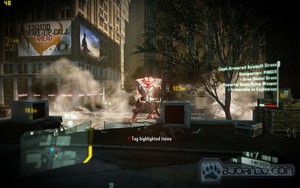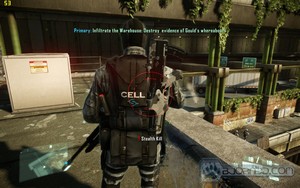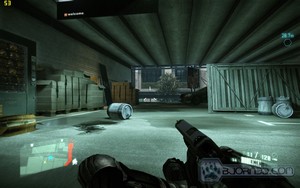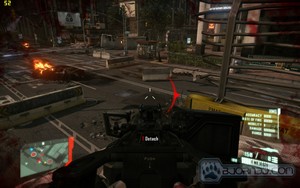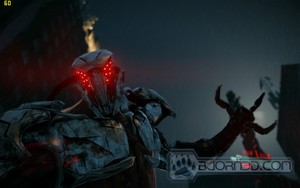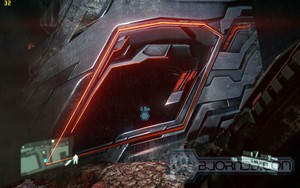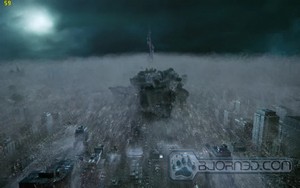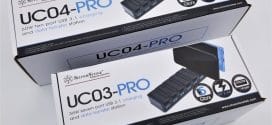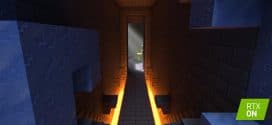In March, Crytek came out with the highly-anticipated Crysis 2. We’re bringing you a little taste of the action.

On March 22nd, the long anticipated Crysis 2 was finally released on the market. Prior to the release, dedicated fans had the opportunity to experience the Demo, which provided a quick glimpse at the multiplayer gaming experience in Crysis 2. 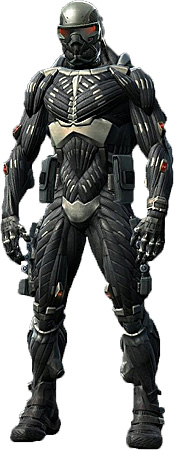 While lacking the actual campaign, the Demo did introduce the multiplayer engine, revealing some of the abilities and modes which the actual game would include. The game is designed as a sequel to both Crysis and Crysis: WARHEAD. However, the settings and the environment are completely different. Instead of the island jungle settings of the previous releases, the game occurs in the city, in particular New York, creating a faster paced environment.
While lacking the actual campaign, the Demo did introduce the multiplayer engine, revealing some of the abilities and modes which the actual game would include. The game is designed as a sequel to both Crysis and Crysis: WARHEAD. However, the settings and the environment are completely different. Instead of the island jungle settings of the previous releases, the game occurs in the city, in particular New York, creating a faster paced environment.
In order to create completely new dynamics, the creators of Crysis 2 introduced a new updated engine: CryENGINE 3. While there are several great engines (like Unreal Engine) that allow for a dynamic gameplay, Crytek went a step further and emphasized the lighting and shadow tessellation as well as a variety of other features in order to create the most realistic environment. This is particularly noticeable, when looking at water rendering. Aside from the wave propagation and ability of water surface to respond to the actions of the player, when submerged a player will find himself engorged in the stream of volumetric sun shafts. It is surprising that the requirements for the Crysis 2 are actually similar to those of the original Crysis. This is partly because Crysis 2 is not a DX 11 game, though it has elements of DX 11 graphics. The release of Crysis 2 was geared not only towards PC, but also other consoles like PS3 and XBOX360, which are unable to render polygonal components nearly as well as the newest graphics cards. CryENGINE 3 can successfully cater to any system without applying too much stress onto the system itself. Unfortunately, Crytek’s decision to cater to the console market results in lower quality textures and polygonal rendering. Though the graphics are by no means bad, they do not have the “wow” factor that Crysis and Crysis: WARHEAD did.
In addition to gameplay and graphical changes, the storyline of Crysis 2 takes on a new turn and brings the player to New York. More on single player and multiplayer will be discussed further in the review.
Here we have a quick overview of gameplay, while the next few pages will go into gameplay explanations, story, performance tests, and much more.
Gameplay
Perhaps the biggest changes in Crysis 2 were made to the gameplay, which is remarkably different from that of its predecessor. Whereas the gameplay in Crysis and Crysis: WARHEAD was a more open game, with much more freedom of movement and action, Crysis 2 is much more linear. Though it does have an enhanced version of the nanosuit (called the Nanosuit 2.0) and some elements of RPG games (greater interaction with individual objects), the overall gameplay of Crysis 2 is much more linear, closely resembling the restricted gameplay of other first-person shooters like the Call of Duty series.
Nanosuit 2.0
The nanosuit in both Crysis and Crysis: WARHEAD was a much simpler version compared to the one used in Crysis 2. Aside from changing the appearance of the nanosuit to make it look stockier and a little tougher, the in-game use has been completely redone.
Crysis and Crysis: WARHEAD featured little interaction with the nanosuit itself, other than changing modes. Crysis 2, on the other hand, features a Nanosuit 2.0, complete spate of customizations that tie in with the story and the way the new nanosuit is built. The suit in Crysis had four basic features: Strength mode, Armor mode, Cloak mode, and Speed mode. In Crysis 2, the nanosuit has three modes: Power mode (a combination of strength and speed), Armor, and Stealth mode (cloak with a few enhancements), along with other features such as the Intelligent Visor (often referred to as “Tactical” mode), and suit and weapon customization. Also, in Crysis and Crysis: WARHEAD, Armor mode was the default mode the nanosuit was set to; in Crysis 2, Armor mode seems to be a separate mode, and the default setting of the suit is presumably some balance between the three configurations.
The suit also contains independent features, such as the intelligent visor. The visor, seen in the first picture above, provides situational awareness and tactical options. When the player enables the visor feature, the intelligent interface displays all hostile and friendly creatures with which the player can interact (in the first picture, the visor shows an enemy CELL Operator about 73 m away from the player, and several ammunition caches just below the player. It also provides tactical options available for the player. The tactical options are shown in the second picture. The player can “mark” units in the game so the visor displays the unit’s firepower, armor, weak points, and affiliation to the player (friendly or hostile), as long as it is open. Marked units also appear as triangles on the player’s HUD and tactical map even after the visor has been disabled. This is useful for avoiding shootouts when outnumbered.
In addition to the intelligent visor, the suit’s “Nanovision” feature shows up an infrared thermal signatures of the surroundings. This is useful in dark areas or at night, when it is difficult to see enemies. It is also mildly useful during the very final part of the game, when the aliens can cloak themselves. However, this feature consumes suit energy, and is somewhat imprecise, as it shows the haze of body heat around around enemies or friendly characters. It also picks up any other sources of heat, including randomly burning fires, guns, ammunition, and even intact red explosive barrels.
The suit also offers a wide range of customizable features, which have a lot to do with the construction of the nanosuit itself. Using a resource called “Nanocatalyst” which is collected from dead aliens, users can customize add-ons to the suit’s modes. For instance, in the screenshot above, the “Threat Tracer” and “Proximity Alarm” modules have been purchased for Tactical mode. Threat Tracer shows bullet paths fired at the player, and Proximity Alarm displays an “Activate Cloak” recommendation on the HUD every time the player nears an enemy that is not aware of them. Each mode has three add-on modules which can be purchased with Nanocatalyst, but unfortunately, players can only enable one module per mode.
Similar to its prequel, Crysis 2 allows users to customize their weapons. Certain weapons can now be customized with an extended clip, an option which was not available in the original Crysis. Similar to the first game, players can customize their weapons with scopes and sights, underbarrel attachments, and more. As in the prequel, certain attachments (such as the Assault scope) must be found on existing weapons in the game before they can be unlocked for other weapons.
The Ceph
The aliens from Crysis 2 are weirdly different from those in Crysis and Crysis: WARHEAD, although they are apparently the same species (called the “Ceph” throughout the game). As in Crysis, there are different types of Ceph units throughout gameplay in Crysis 2.
The game has four levels of Ceph.
- Grunt: The most basic type of Ceph encountered. These can be killed fairly easily with a few shots from an automatic weapon. They can also be stealth-killed or killed by grabbing and throwing. Dead Ceph Grunts leave behind 100 Nanocatalyst.
- Grunt Commander: Slightly more powerful than the Ceph Grunt, and more heavily armored. These take a little more time to kill. They also move faster and fire more deadly weapons, so players should stay mobile. However, like Ceph Grunts, these can be stealth-killed or killed by grabbing and throwing. Dead Ceph Grunt Commanders leave behind 300 Nanocatalyst.
- Devastator: The most powerful type of Ceph usually encountered. These are extremely heavily armored, and should never be taken on in close combat. Due to their extremely powerful weapon and strong armor, it is best to outmaneuver them and use heavy weapons or explosive ordinance. Dead Ceph Devastators leave behind 500 Nanocatalyst.
- Guardian: These are the deadliest type of Ceph unit encountered. They can cloak themselves, and have extremely powerful close combat melee attacks, and should be attacked from range. These are only found in the very final part of the last mission, guarding the entrance to the Ceph’s main hive. Dead Ceph Guardians leave behind 5000 Nanocatalyst.
Also appearing periodically throughout the game are enemy armored heavy assault units, called Pingers. Pingers are immensely powerful area denial drones which fire sonic pulses that deplete the nanosuit’s energy. They are heavily armored on their front, but are vulnerable to rockets, grenades, and heavy explosives on their rear surface. Regular gunfire is useless against Pingers. Destroyed Ceph Pingers leave behind 3000 Nanocatalyst.
Interaction
In addition to the changes in the Nanosuit and the Ceph, there are also some changes to the way players can interact with their environment. As in the original Crysis, players can pick up and throw random objects scattered along the ground. Unlike Crysis, however, interaction in Crysis 2 offers tactical benefits. For instance, throwing random objects distracts enemies as they turn towards the place where the object landed. In addition, players can attach C4 or the L-TAG grenade launcher’s sticky-bomb ammunition to explosive red barrels and throw the barrels at enemies.
As mentioned above, players can also stealth-kill their opponents by sneaking up behind them and pressing the melee button. The Tactical Visor will often display stealth-killing as a tactical option available to players, though stealth-killing is harder when there are several enemies grouped together. For obvious reasons, stealth-killing can only be done from behind an opponent; pressing the melee button against an enemy that is facing the player will execute a regular melee attack, and will disable invisibility if the player is cloaked.
Crysis 2 also offers different mobility options. Players can execute higher jumps (known as strength jumps in Crysis) simply by holding the jump button when next to a high ledge. In Crysis, players could move at four different speeds–walking, running, walking in Speed Mode, and running in Speed Mode. Walking in Speed mode was slightly faster than walking regularly, but did not consume any suit energy. Similarly, running regularly did not consume suit energy. In Crysis 2, these have been disabled–users can either walk or run, and running consumes suit energy. Players can also powerslide under gates and low-hanging edges. Powersliding is a fast way to lose enemies, though it is far easier to evade human soldiers than it is to evade Ceph units.
In addition, Crysis 2 also offers more vehicle and weapon options. For instance, players can use both the cannon and rocket pods when driving armored vehicles, and can even detach mounted heavy machine guns to take with them. Taking mounted heavy machine guns severely decreases both player mobility and the accuracy of the machine gun. Like Crysis, players can carry up to three rocket launchers (called the Joint Anti-tank Weapon in Crysis 2). However, mobile heavy machine guns and JAW rocket launchers cannot be stored in the inventory, and are discarded after the ammunition is expended.
Story
Alert: Spoilers Ahead. Please approach cautiously.
The storyline of Crysis 2 is heavily tied into the Nanosuit 2.0. The game starts in New York City in 2023, three years after the events of the original Crysis. The outbreak of a mysterious virus (called the “Manhattan virus”) that causes complete biological breakdown has caused mass panic in New York. This, coupled with fears of an invasion by the Ceph, lead the government to place Manhattan under martial law, and the US Department of Defense contracts soldiers from the private military company Crynet Enforcement & Local Logistics (CELL) to restore law and order.
A USMC Force Recon unit is deployed to New York City by the submarine USS Nautilus, with the objective of extracting former Crynet employee Dr. Nathan Gould, who appears to have the key to combating the impending Ceph invasion. However, Ceph attack the sub before the team can be fully deployed, and the only apparent survivor is the mortally wounded player character, simply called “Alcatraz”. At this point, Delta Force Maj. Laurence “Prophet” Barnes, one of the main characters in Crysis, appears and save Alcatraz. However, Prophet himself has been infected by the Manhattan virus, and sees only one way out of the situation–he gives Alcatraz the Nanosuit 2.0, and kills himself so the nanosuit will stop associating itself with him, and will instead assimilate with Alcatraz. Assuming that Alcatraz is Prophet, Gould contacts him and asks him to proceed to his laboratory, which is heavily guarded by CELL soldiers working for CELL Commander Dominic Lockhart. Lockhart had previously targeted Prophet as an active biohazard due to his infection. The player is therefore forced to fight through severa levels of CELL operatives in the beginning of the game.
On his way to Gould’s lab, Alcatraz witnesses CELL helicopters shoot down a Ceph dropship, and is asked by Gould to retrieve samples from it. Though the dropship only contains human tissue, Alcatraz is attacked by a Ceph Grunt. Alcatraz retrieves tissue samples from the dead Ceph, but finds that it causes a strange reaction with his nanosuit. It is at this point that the changes to the Nanosuit 2.0 start becoming apparent. Up till Crysis 2, the nanosuit was inferred to be purely electromechanical. Throughout Crysis 2, however, it becomes apparent that the Nanosuit 2.0 is actually biologically based and highly intelligent, almost to the point of being a self-aware organism. Alcatraz makes his way to the lab, and reveals his identity to Gould. Though Gould is initially reticent, he eventually begins to trust him and informs him that ever since the suit absorbed the alien tissue, or Nanocatalyst, the suit’s deep layers have been processing a mysterious code with an unknown purpose. Gould theorizes that scanning these deep layers will reveal the mystery, and orders Alcatraz to the Crynet base on Wall Street. Since Crynet is the manufacturer of the nanosuit, their base has advanced technology that can reveal the suit’s mysteries. However, this plan is interrupted when both Alcatraz and Gould are ambushed by CELL Operatives Lockhart and Tara Strickland, the daughter of Maj. Strickland from Crysis.
During the middle of a prisoner transfer outside the building, the Ceph attack the CELL personnel as a massive alien spire rises from underneath the Crynet building, releasing a spore-based bioweapon similar to the Manhattan virus, that kills most of the CELL troops in the immediate area. Alcatraz is left stranded, while dealing with a suit malfunction caused by the spore virus. However, the suit is rebooted remotely by Jacob Hargreave, a centenarian who apparently was forewarned of the Ceph and had spent most of the previous century planning against their invasion. Hargreave is one of the founders of Hargreave-Rasch Biotechnologies (the parent company of Crynet), and had stolen Ceph technology to design the Nanosuit as the ultimate weapon against the Ceph. Hargreave orders Alcatraz to enter one of the spires, to test whether the Nanosuit is able to interact with the Ceph technology. Meanwhile, the DoD rescinds CELL authority over Manhattan and deploys Marines under the command of Col. Sherman Barclay, who attempts to drown out the Ceph by destroying the city’s flood barrier. Washed away by the water, Alcatraz is found by a band of Marines, including his comrade Chino, who also survived the Ceph attack on their sub at the beginning of the game. Together with the Marines, Alcatraz aids in the hasty evacuation of civilians from Grand Central Station.
Hargreave then contacts Alcatraz and reveals that the Nanosuit is busy analyzing the Ceph tissue samples that Alcatraz had previously recovered, and is now rewriting its own code to interface with the Ceph technology. He orders Alcatraz to the Hargreave-Rasch Building, the research facilities of Hargreave-Rasch Biotechnologies. There, Alcatraz is told to find a stabilizing agent in the bio-lab to facilitate the Nanosuit’s analysis, but the Hargreave-Rasch complex is attacked by a Ceph Pinger and is completely flooded, washing Alcatraz out of the building and leaving him unable to enter the bio-lab. Seeing that there is no way back into the building, Hargreave instead orders Alcatraz to regroup with the Marines. At the terminal, Alcatraz is reunited with Gould, who had apparently “escaped” Tara Strickland, a claim of which Col. Barclay is skeptical. Knowing that Strickland is an ex-Navy SEAL who left the military to join CELL, Barclay concludes that Strickland must have intentionally released Gould from captivity. As Grand Central Station is overrun by Ceph forces, the Marines fall back to the secondary evacuation point, Times Square.
At Times Square, another Ceph spire rises from the ground, However, by this time, the Nanosuit has finished processing the spores, and Alcatraz manages to enter the spire, allowing his Nanosuit to interact with it and re-purpose the spores to be lethal to the Ceph. This causes a cataclysmic self-destruction of the Ceph in the area, and apparently removes all traces of the biological warfare agent. With the evacuation from Times Square complete, Hargreave instructs Alcatraz to make his way to Roosevelt Island. There, Alcatraz is told to infiltrate a Hargreave-Rasch complex named “The Prism”, where Hargreave resides. However, Alcatraz is faced with CELL forces led by Commander Lockhart, who still intends to kill him, against Hargreave’s direct orders. After witnessing his commander’s betrayal, Hargreave orders Alcatraz to kill Lockhart, and end his interference once and for all. Alcatraz manages to kill Lockhart, but as he makes his way through the island, he is captured by CELL operatives loyal to Hargreave, who wants the Nanosuit for himself so that he can finish off the Ceph personally. Hargreave then attempts to remove the Nanosuit from Alcatraz’s body. However, the Nanosuit rejects its removal from Alcatraz since it has already completely assimilated with its wearer, revealing flashbacks of Prophet’s fallout with Hargreave in the process.
Apparently, due to its biological nature, the suit becomes symbiotic with its wearer, and when Prophet’s team in the first Crysis approached the Ceph, their suits’ basis in Ceph technology turned them into “dead men walking”. In the flashback, Prophet accuses Hargreave of this, and of using his men (Nomad and Psycho’s strike team from Crysis and Crysis: WARHEAD) as guinea pigs to find out what would happen when a human wearing the Ceph-technology based suit approached a main Ceph hive. By now, it is apparent that the nanosuit’s biological nature means that it is more than an armored shell, and that it has an effect on those who wear it. While at the Crynet base on Wall St., it is revealed that Alcatraz was fatally wounded in the submarine explosion, and the suit is keeping him alive by intelligently interacting with his body, growing into his heart and lungs to prevent him from bleeding to death. Similarly, whenever Alcatraz picks up the Nanocatalyst, his suit senses it as biological tissue which it then analyzes and integrates into its basic structure (this seems to form the basis for the Nanocatalyst upgrade modules players can purchase).
Alcatraz is saved by Strickland, who reveals herself to be an undercover CIA operative, and the one responsible for ordering the original deployment of the Force Recon team to New York. Strickland tells Alcatraz that Hargreave has grown senile in his old age, and believes himself to be the only sane human; she tells Alcatraz to capture Hargreave for interrogation, but upon entering Hargreave’s private office, Alcatraz sees that Hargreave is nowhere to be found. Hargreave, via a large holographic screen, reveals that he has been in a cryogenic vegetative state for over a century since an encounter with the Ceph at Tunguska, and that his consciousness is only able to communicate and interact through the use of a computerized system. He gives Alcatraz a final Nanosuit upgrade, the “Tunguska Iteration”, before the Ceph invade the island. Hargreave triggers a countdown timer for the self-destruction of the complex, and convinces the remaining CELL forces to aid Alcatraz’s exfiltration. Alcatraz barely escapes the massive explosion, which destroys much of Roosevelt Island and the Queensboro Bridge. On the shores of Manhattan, Alcatraz reunites with Gould, Strickland and Chino.
Alcatraz is notified by Col. Barclay that the Department of Defense, in a desperate plan to destroy the invaders, has decided to launch a tactical nuclear strike on Manhattan Island, with little regard to collateral damage and nuclear fallout. Gould argues that the strike is not likely to work, just as the nuclear strike on the Lingshan Islands during the events of the first Crysis did not. Barclay replies that unless Alcatraz can somehow neutralize the Ceph within 20 minutes, the government will execute the strike due to the lack of alternatives. As Alcatraz and his comrades make their way through the city toward the center of the alien infestation, a massive alien “litho-ship” rises out of the ground beneath Central Park, lifting a large section of the park into the air. With the help of Gould, Strickland, and Barclay, Alcatraz assaults the floating section of Central Park and makes his way to the alien spire at its center, which serves as a massive dispersal point for the Ceph’s spore bio-weapon. He enters the spire, and his Nanosuit, with the Tunguska Iteration upgrade, is able to re-purpose the spire’s bio-weapon to turn against the Ceph, killing all Ceph soldiers in New York in the process. Alcatraz, while unconscious, communicates with Prophet (whose memories, experiences, and personality had been stored in the symbiotic suit), who states that while the mission in New York is a success, it is only the beginning. The Ceph have been on earth for millennia, and have built all over the world, not just New York and Lingshan. The Nanosuit, before rebooting again, states that assimilation is complete, and Prophet’s memories become “assimilated” into Alcatraz. Upon regaining consciousness in Central Park, Alcatraz receives a broadcast from Karl Ernst Rasch, the other founder of Hargreave-Rasch, asking for his name. Climbing out of the crater and speaking for the first time in the game, Alcatraz responds, “They call me Prophet.”
Testing
To test the performance of Crysis 2, we will run FRAPS and play the same part of the game several times to get an average reading for the graphics settings. We will use one system, our main gaming system which is described below in the specifications table. We will run the game at different resolutions and settings to address the system specifications for Crysis 2. It is important to note that we did not have Vsync on however Crysis 2 seems to have a limitation at 120 FPS even without Vsync on.
Minimum System Requirements:
- Operating System Windows XP (SP3), Windows Vista (SP2), or Windows 7
- Processor Intel Core 2 Duo, AMD Athlon X2, or equivalent, running at 1.6 GHz or greater
- Memory (RAM) 1.5 GB
- HDD Space 9 GB available
- Video Card DirectX 9.0c compatible, 256 MB of VRAM; NVIDIA GeForce 7600 GS, ATI Radeon HD 2400 Pro 256 MB, or greater
- Soundcard DirectX 9.0c compatible, 16-bit
- Disc Drive 16X CD/DVD Drive
- Network Internet (TCP/IP) connection
Our Recommended System Requirements for maxing out the game at 1920×1080:
- Operating System Windows XP (SP3), Windows Vista (SP2), or Windows 7
- Processor Intel Core i5, i7, AMD Athlon X4, or equivalent, running at 2.6 GHz or greater
- Memory (RAM) 4.0 GB
- HDD Space 12 GB available
- Video Card DirectX 11 Compatible, 1GB of VRAM; NVIDIA GeForce 460 or greater
- Soundcard DirectX 9.0c compatible, 16-bit
- Disc Drive 16X CD/DVD Drive
- Network Internet (TCP/IP) connection
Our Test Setup |
|
| Case | Silverstone Temjin TJ10 |
| CPU |
Intel Core i7 2600K @ 4.8 GHz |
| Motherboard |
GIGABYTE P67A-UD7 |
| Ram |
Patriot Gamer 2 Series 1600 MHz Dual-Chanel 16GB (4x4GB) Memory Kit |
| CPU Cooler |
Heatblocker Rev 3.0 LGA 1156 CPU Waterblock Thermochill 240 Radiator |
| Hard Drives |
4x Seagate Cheetah 600GB 10K 6Gb/s Hard Drives 2x Western Digital RE3 1TB 7200RPM 3Gb/s Hard Drives |
| SSD | 1x Zalman SSD0128N1 128GB SandForce SSD |
| Optical | ASUS DVD-Burner |
| GPU |
2x Nvidia GeForce GTX580 in 2-Way SLI |
| Case Fans |
1x Quiet Zalman Shark’s Fin ZM-SF3 120mm Fan – Top 1x Silverstone 120mm fan – Front 1x Quiet Zalman ZM-F3 FDB 120mm Fan – Hard Drive Compartment |
| Additional Cards |
LSI 3ware SATA + SAS 9750-8i 6Gb/s RAID Card |
| PSU |
Sapphire PURE 1250W Modular Power Supply |
| Mouse | Razer Mamba |
| Keyboard | Logitech G15 |
| Monitor |
Asus VG236H 23″ 120Hz 3D Monitor (1920×1080) |
| Speakers | Logitech Z-2300 2.1 THX Certified Speakers |
Performance
Crysis 2 is surprisingly light on graphical requirements copmared to previous Crysis titles. Many thought that Crysis 2 might have such intense graphics that even the most recent video cards would have a hard time rendering the game at maximum settings, though this was not the case with Crysis 2. Crytek seemed to take a different approach by trying to balance the eye candy with the graphical optimizations in CryENGINE 3, and making sure that even some older hardware are able to smoothly play Crysis 2 at high resolutions (this allows Crytek to reach the console market, which often has lower graphical capability than PC gaming). This is great news for those that were afraid that their systems might not be powerful enough to play Crysis 2, but of course it has also caused a firestorm among those gamers that have upgraded their systems in anticipation for Crysis 2, only to find that Crysis 2 is actually worse in some counts than Crysis, a fact that we were disappointed by. In addition, we were also disappointed to see that there is very little graphical customization available: players cannot tweak individual features such as anti-aliasing, texture quality, or anisotropic filtering; instead, the customization is limited to three preset levels: Gamer, Advanced, and Hardcore.
Of course there are different ways to approach it. In some cases, the graphics looked amazing, and we wondered how Crytek was able to create such clarity without performance bottlenecks. In other instances, quality degradation is quite visible, especially in fire, explosion, and smoke scenes. There are less fog and smoke levels and fire seems more abstract and very unrealistic.
Here are the frames per second we got after playing the last mission of Crysis 2 several times on different resolutions and settings:
| Resolution/Settings | Average Frames Per Second (Higher is Better) |
|---|---|
| 1920×1080, Extreme in 3D, |
52 FPS |
| 1920×1080, Very High in 3D |
62 FPS |
| 1920×1080, High in 3D | 74 FPS |
| 1920×1080, Extreme | 95 FPS |
| 1680×900, Extreme | 102 FPS |
| 1280×720, Extreme | 118 FPS |
We can confirm the previous overview about graphics in the results, as we can see that Crysis 2 at 1920 x 1080 at maximum graphics performance and also in 3D gets 52 frames per second. This is plenty for extremely smooth gameplay. As we continued benchmarking the cards with the lower resolutions and lower graphics settings, the performance started rising. For those who want to know how a single NVIDIA GTX 580 would do with Crysis 2, we suggest looking at the 3D scores, since those require the 3D content to be rendered twice on the screen to create an image for both eyes. Those that just want pure SLI performance can look at the non-3D results. Crysis 2 got a whopping 95 FPS at 1920×1080 after taking 3D off, and this should be plenty even for the enthusiast gamers, especially those playing online.
Editor Aditya Gune took a look at the gaming experience with a GTX 560 Ti video card. He confirmed that he finished playing the game at 1680×1050 maxed out without any lags. His system also uses an Intel Core i5-2500K processor, but it is currently running at stock speeds. He also confirmed that performance was still smooth at 1920×1080 with maximum graphics settings. Those that have older hardware should not have a problem playing Crysis 2 maxed out if a single GTX 560 Ti was able to play the game smoothly without any lags at that intensity.
We are very glad that Crytek decided to really take graphics optimization into account in Crysis 2 and the CryENGINE 3.
3D Experience and Multiplayer
The 3D experience in Crysis 2 was quite pleasant. A month ago we got a chance to play Bulletstorm in 3D and we were very impressed. Overall, Crysis 2 has some excellent 3D capabilities. CryENGINE 3 was designed with 3D in mind, so there was no doubt that 3D would be fully supported in Crysis 2.
Overall our exerience with 3D and Crysis 2 was pleasant because while graphics looked pretty good in 2D, the 3D experience just brought a bit more realism to the game. The explosions and the environment had much more depth to them, even making some of the downgraded materials look better. Even though sometimes we found ourselves playing Crysis 2 with the 3D settings set half ways up in the Nvidia Drivers, the 3D experience was subtle most of the time, creating a very comfortable 3D depth and quality. There were times when we got so immersed in the gaming experience and the story that we even forgot we were wearing the 3D shutter glasses.
We find 3D especially fun in Multiplayer mode, because there seem to be no problems with images separating, and the crosshair is clearly visible during gameplay without the 3D side effects that older games show. Because of this, there are no gaming disadvantages during Multiplayer in 3D, and it just brings a tad bit more fun into the game.
To quickly sum up Multiplayer mode, it is extremely similar to the multiplayer in Call of Duty 4: Modern Warfare, as it consists of a ranking system. The player collects points by killing enemies in creative ways, or by protecting crash sites during a multiplayer game, and once the points add up to a certain number, the user advances in rank. These rank advancements allow the user to upgrade their nanosuit’s functions and their weapons to dominate against their enemies.
Just like in Call of Duty 4, Crysis 2 also has a number of kill bonuses. For the bonus to work, the player needs to collect the dogtags of each player kill. The bonuses are highlighted below:
Maximum Radar
- (3 Dog Tags) Highlight enemies on the radar.
Radar Jammer
- (5 Dog Tags) Scramble the radar of all enemies.
Nanosuit Jammer
- (5 Dog Tags) Deploy a Nanosuit disruption capsule.
Ceph Airstrike
- (7 Dog Tags) Summon a Ceph gunship to bombard enemies.
Maximum Nanosuit
- (7 Dog Tags) Overcharge your Nanosuit armor.
Orbital Strike
- (5 Dog Tags) Unleash a devestating orbital beam attack.
The only difference between Call of Duty 4 and Crysis 2 is that Call of Duty 4 does not have a nanosuit. In Crysis 2, players can enjoy cloaking to become an ultimate sniper, enhanced armor for intense shootouts, or more interactive attacks like air stomps. Nanovision and Tactical mode are also available, which can come handy sometimes for snipers. From the short multiplayer gameplay, especially in the Crysis 2 Demo, the main multiplayer levels we came across were deathmatch, and “protect the crash site” type levels.
Conclusion
After taking a closer look at the long anticipated Crysis 2 and taking the time to beat the campaign as well as dwell in the realm of multiplayer, we have come to appreciate the new and refined version of Crysis. Packed with constant action without a minute to rest, players will enjoy the fast-paced environment. In terms of quality of gameplay and the console control, Crysis 2 is an amalgam of other popular shooter games like Battlefield, Call of Duty, and in some way resembles Mirror’s Edge in terms of interaction. The player is no longer limited to a mere assault rifle, and will sometimes find close combat or an air stomp to be a more effective tool to their survival. While management of weaponry, including the attachments, is crucial for long range interaction, the Nanosuit is a nice complement to the arsenal of weaponry. Crysis 2 offers greater interaction with the Nanosuit than its predecessor did, and it is worth noting that the Nanosuit can be adapted to enchance player’s gamestyle. Players more comfortable with stealth and silent kills can utilize enchancements like Stealth and Mobility Enchance.
The storyline of the game is very engaging, and revolves around the Nanosuit itself. Though this seems to be a departure from previous Crysis titles (the nanosuits in Crysis and Crysis: WARHEAD were very simple), it adds a refreshing element of surprise, and keeps players on their toes. Players have to complete 19 missions in order to complete the campaign of Crysis 2. This might not seem like a lot, but players should expect this game to take roughly 14 hours.
Finally, the most important thing to note is the optimization that Crysis 2 has undergone in order to cater to a large diversity of gamers. While the first release of Crysis 2 was primarily based on DX9, it was welcomed by majority of the gamers due to the low system requirements. For those that wish to experience Crysis 2 at its best, further patches that support DX11 and advanced graphics will serve as an excellent option.
| OUR VERDICT: Crysis 2 | ||||||||||||||||||||
|
||||||||||||||||||||
| Summary: Crysis 2 is a fun first-person shooter which will provide several hours of gameplay. It’s innovative and creative story is sure to please, and players should find the gameplay attractive. For its fun factor, gameplay, and storyline, we award Crysis 2 the Bjorn3D Silver Bear Award. |
 Bjorn3D.com Bjorn3d.com – Satisfying Your Daily Tech Cravings Since 1996
Bjorn3D.com Bjorn3d.com – Satisfying Your Daily Tech Cravings Since 1996














